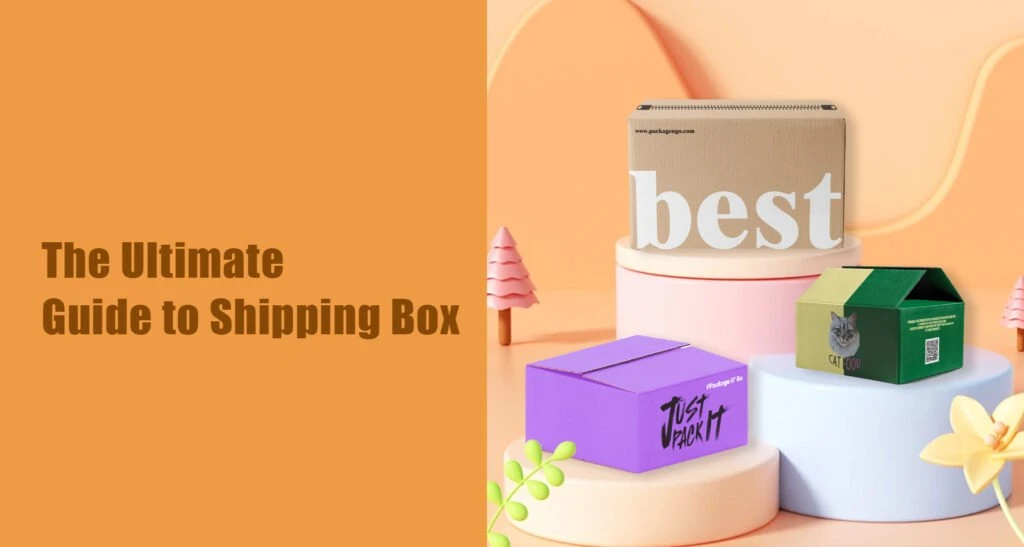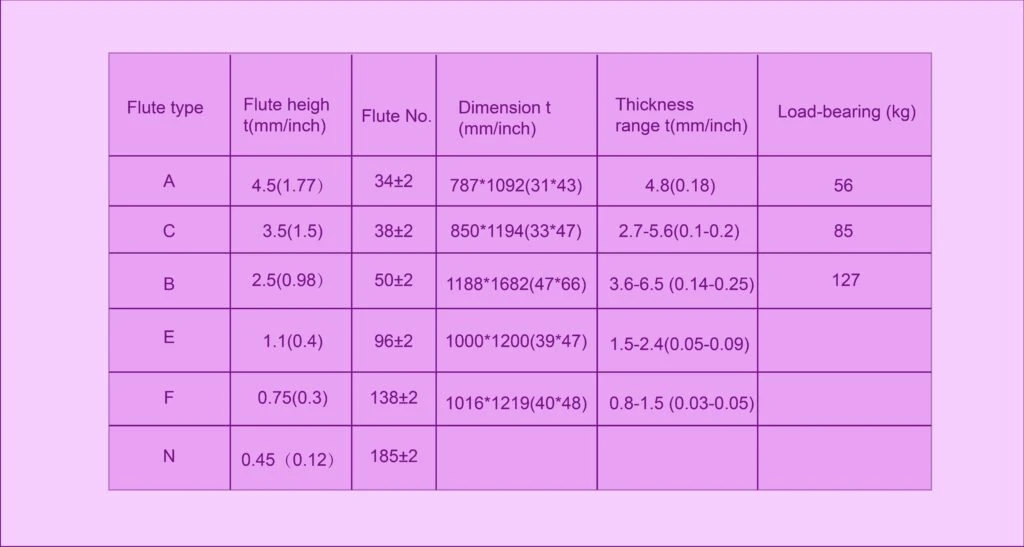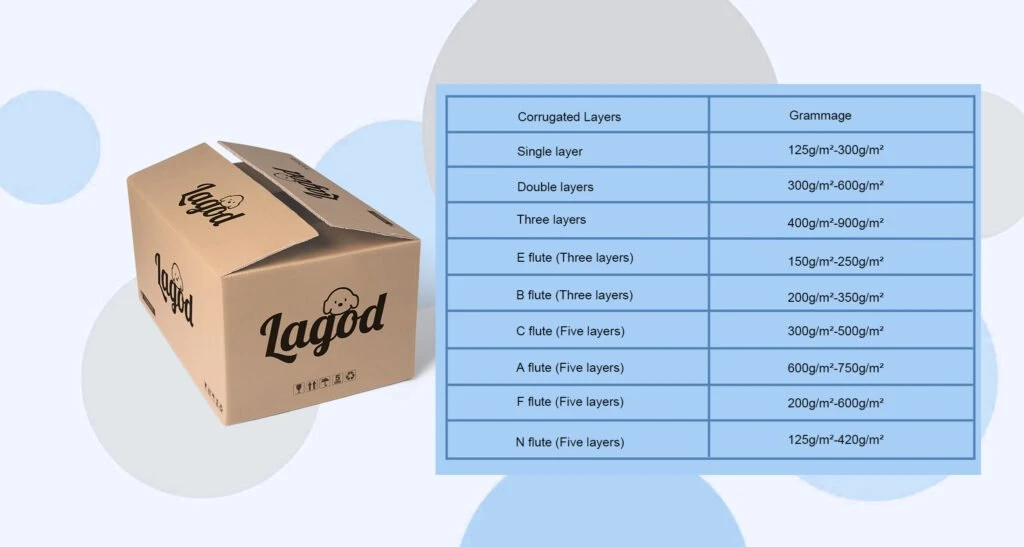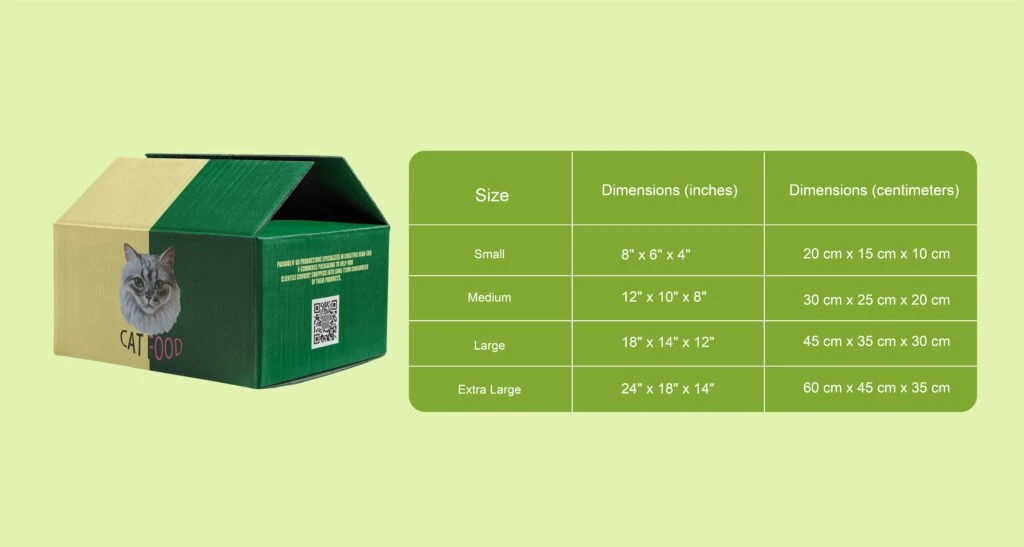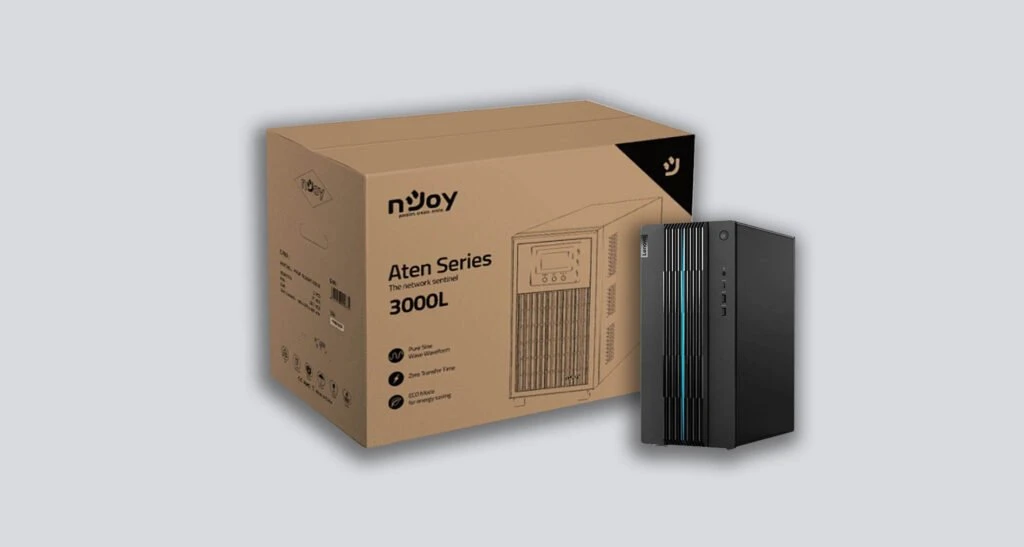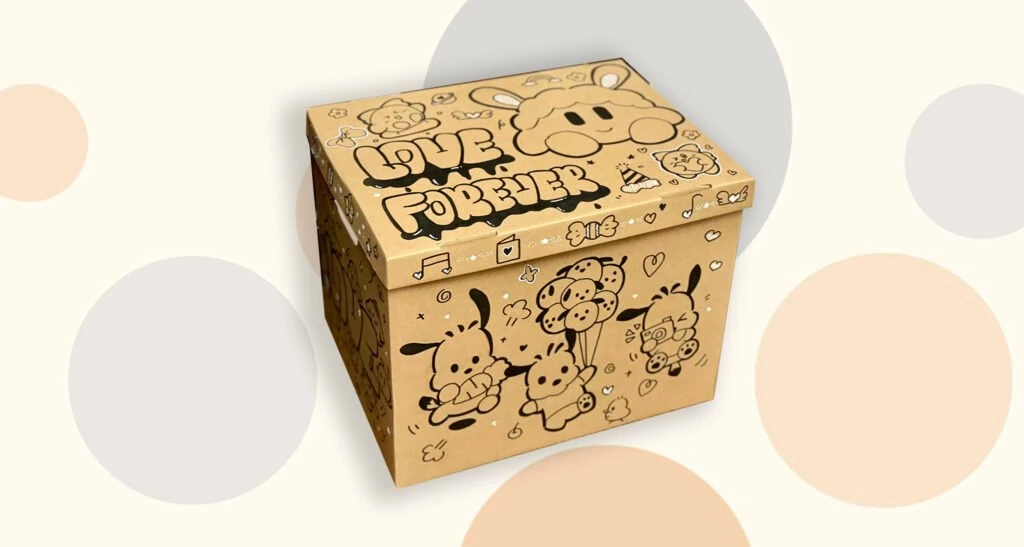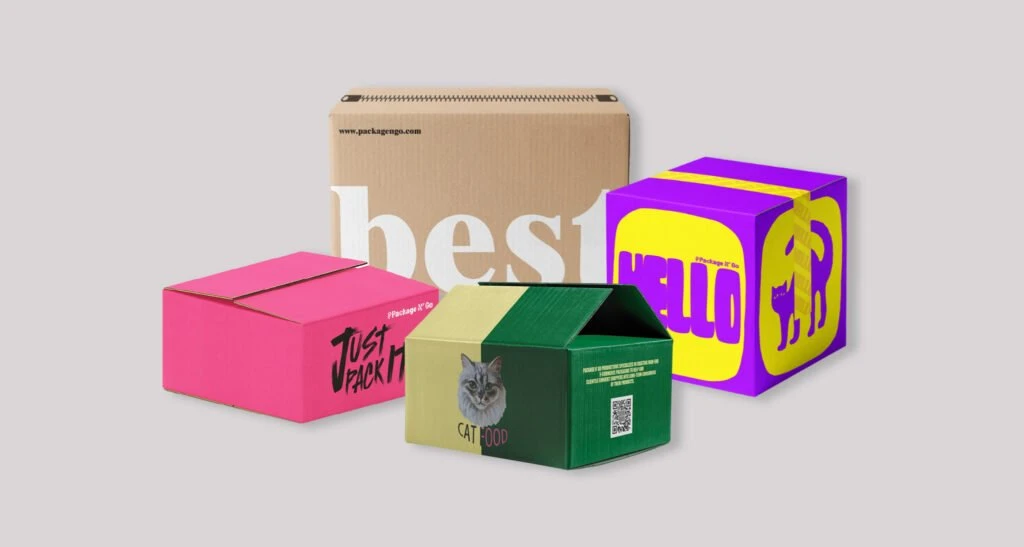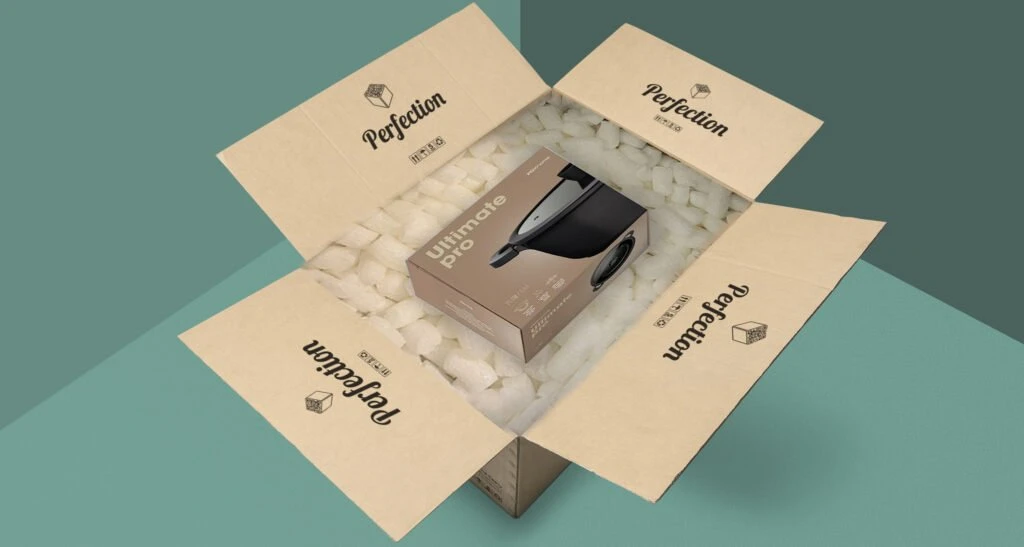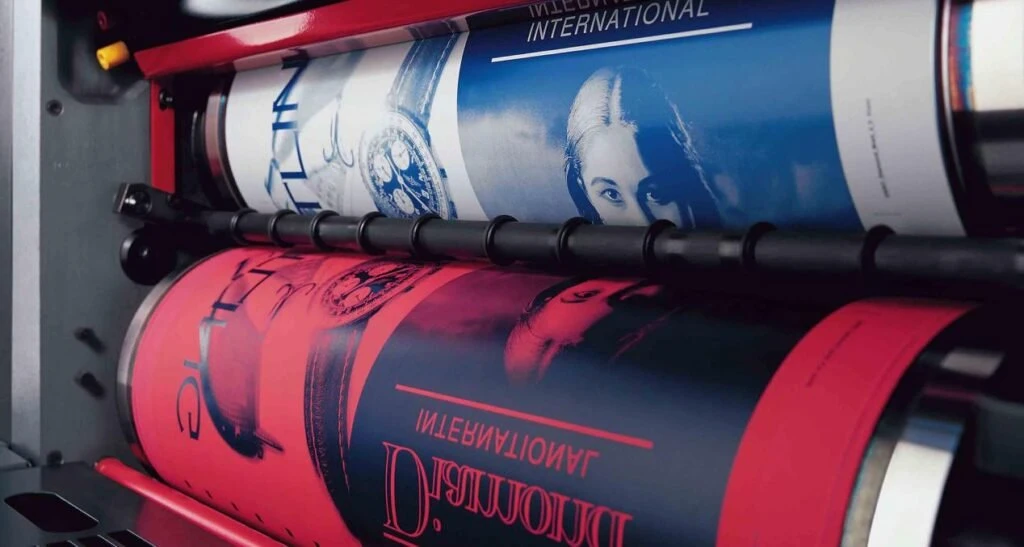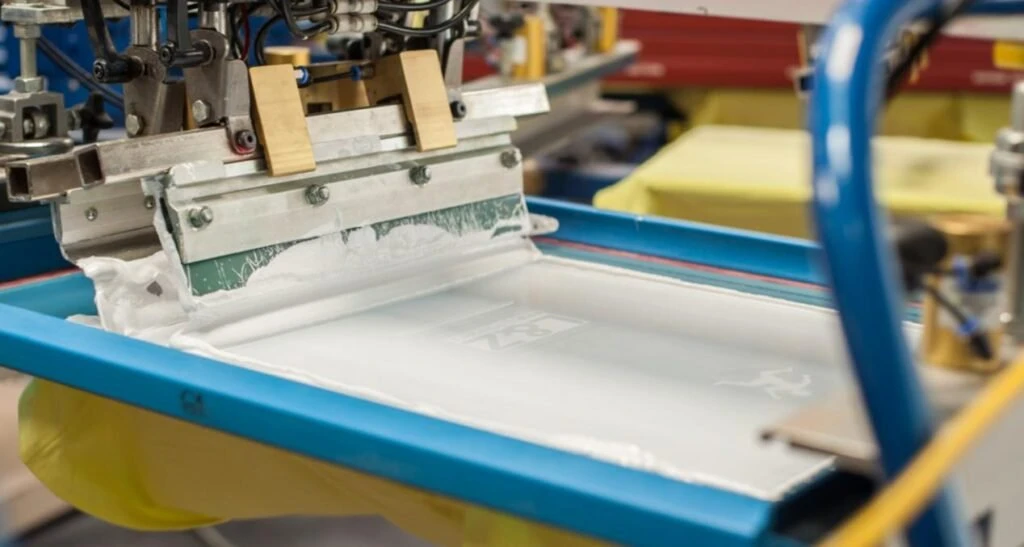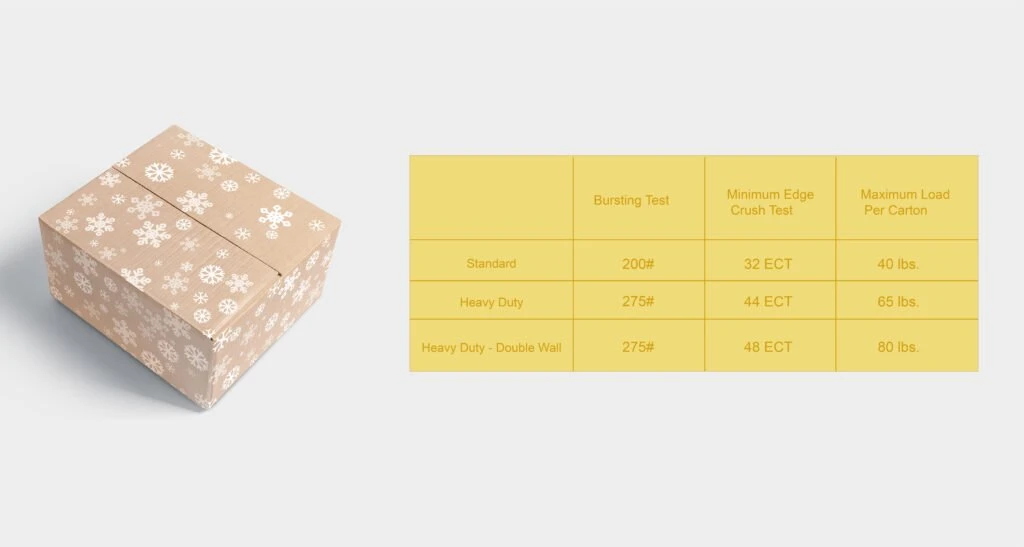Table of Contents
Chapter 1: Understanding shipping boxes
1.1 What is a shipping box?
The shipping box has a straightforward design, formed by folding and creasing a single piece of cardboard. It includes four three-dimensional panels: two long side panels and two short side panels, which can be folded and secured with adhesive tape or other methods. Usually, it also features a lid and a bottom that match its dimensions, enabling complete closure. Shipping boxes are used for packaging and transporting various products, known for their convenience, cost-effectiveness, and efficiency, making them widely used in the logistics industry.
1.2 What are the materials of shipping boxes?
1.2.1 Corrugated cardboard
Corrugated cardboard is one of the primary materials used in making paper boxes. It consists of one or two layers of corrugated cardboard and two or three layers of flat paper. There are various types of corrugated cardboard, classified based on the flute type as A, B, C, E, N, F, and N.
We can refer to the grammage of corrugated cardboard in this form:
1.2.2 Boxboard paper
Boxboard paper is the surface layer paperboard used in corrugated cardboard boxes, requiring high strength and good toughness, made from sulphate pulp. Depending on the quality and usage requirements of the boxes, boxboard paper is classified into five grades: A, B, C, D, and E. Grades A, B, and C are linerboard paperboards, while grades D and E are regular paperboards. Grade A boxboard paper is suitable for manufacturing large corrugated cardboard boxes used for fine, valuable, and refrigerated items packaging. Grade B boxboard paper is suitable for manufacturing corrugated cardboard boxes used for export (long-distance transportation) packaging. Grade C boxboard paper is suitable for manufacturing corrugated cardboard boxes used for packaging larger items. Grade D boxboard paper is suitable for manufacturing corrugated cardboard boxes used for packaging general items. Grade E boxboard paper is suitable for manufacturing corrugated cardboard boxes used for packaging light-load goods.
Boxboard paper comes in 14 varieties with grammage ranging from 200 to 530 g/m2, available in flat sheets and rolls.
The dimensions of flat sheets are: 787mm * 1092mm (31 * 43inch), 960mm * 1060mm (38 * 42 inch), and 960mm * 880mm (38 * 35 inch).
The roll paper widths are: 960mm (38 inches), 1100mm (43 inches), 1600mm (63 inches), and 1940mm (76 inches).
1.2.3 Linerboard
Linerboard typically requires a grammage of 110 GSM or higher. The standard dimensions for paper sheets are usually regular size 787 * 1092 mm (31 * 43 inches) and large size 889 * 1194 mm (35 * 47 inches). The common types of linerboard paper sheets are as follows:
Coated paper
Coated paper, also known as printing paper, is created by applying a layer of white pulp onto the original paper and then calendering it. It has a smooth surface, high whiteness, uniform fiber distribution, consistent thickness, minimal expansion and contraction, good elasticity, strong water resistance, and tensile properties. It’s also great for ink absorption.
There are different textures like cloth-coated and grain-coated paper, and it can be single-sided (one side coated) or double-sided (both sides coated).
A. Single-sided: Used for cartons, boxes, tote bags, and medium to high-grade printing.
B. Double-sided: Available in weights from 80g to 400g, suitable for high-grade printing.
When printing on coated paper, use offset resin ink and glossy ink to avoid pressure issues and back sticking. Employ anti-dirty agents, powder spraying, or other methods to prevent dirtiness.
Matte art paper
Matte art paper is distinguished from coated paper by its matte surface. It offers uniform fiber distribution, good thickness, high density, excellent elasticity, strong water resistance, and tensile properties. Although its ink absorption and acceptance are slightly lower than coated paper, it makes up for it with a slightly higher thickness. Matte art paper is mainly utilized for elegant, high-grade color printing, such as albums, cards, postcards, and exquisite product samples. It is typically available in grammages ranging from 80gsm to 350gsm.
SBS (Solid Bleached Sulphate)
SBS, made from bleached chemical pulp and fully coated with adhesive, is suitable for printing and product packaging, with a typical basis weight of 150gsm or higher. White cardboard, with three layers, has smooth white surfaces for double-sided printing, and a filler middle layer made from lower-grade materials. It’s rigid and versatile, used in high-end packaging like boxes, cigarette cases, cups, children’s books, and for binding purposes such as softcover book covers, pamphlets, manuals, and hard linings.
CCNB (Clay Coated News Back)
CCNB (Clay Coated News Back) is a white and smooth paperboard on the front side, with the back side typically being grey. It’s commonly used for making paper boxes after single-sided color printing, for packaging, or for crafting handmade products. CCNB comes in standard grammages ranging from 230 g/m² to 500 g/m², and more.
Fancy paper
Fancy paper refers to specialty papers designed for specific purposes with relatively limited production volumes. It includes various types of special-purpose papers and artistic papers. Today, sellers use the term “fancy paper” as a collective term for artistic papers like embossed paper, aiming to simplify the confusion arising from the wide variety of paper types.
1.3 What are the uses of shipping boxes?
Home appliances and hardware machinery products are typically packaged in rigid cardboard boxes due to their excellent moisture resistance, shock absorption, and protective properties.
Fragile items, food products, clothing, and daily essentials are best suited for corrugated cardboard boxes, which provide cushioning, protection, and secure packaging.
Watches, jewelry, cosmetics, small household appliances, and gifts are mainly packaged in carton boxes made from sturdy cardboard, suitable for protecting these valuable or fragile items.
Beverages, vegetables, fruits, and seafood are suitable for wave paper boxes due to their excellent waterproof properties.
Electronic products such as phones and computers are usually packaged in paper boxes to protect them from impact and compression.
Food items like cakes, bread, cheese, fruits, and vegetables are packaged in paper boxes to maintain freshness and taste.
Pharmaceuticals require strict packaging standards, and paper boxes can provide sealed packaging and double-layer protection to prevent contamination and damage.
1.4 Common sizes
Here are some common sizes of shipping boxes:
1.5 What are the benefits of shipping boxes?
Structural stability: The design of shipping boxes ensures durability and safety during transportation and storage.
Flexible sizing: Customizable based on product size and shape, meeting various packaging needs.
Cost-efficient: Compared to materials like wood, shipping boxes have lower production costs and lighter weight, reducing transportation expenses.
Easy storage and transportation: Foldable design saves storage space when not in use and facilitates transportation.
Environmentally sustainable: Shipping boxes are recyclable and biodegradable, meeting environmental standards and reducing pollution.
Water-resistant, mold-resistant, fire-resistant: Some types of shipping boxes (like double-wall corrugated boxes) possess these characteristics, effectively protecting enclosed items.
Suitable for various occasions: Whether for valuable items or regular goods, shipping boxes provide appropriate protection and convenient packaging solutions.
Customization options: Sizes, colors, and patterns can be customized to meet specific packaging and transportation needs.
Simple and quick sealing: The flap-style sealing allows for fast and convenient closure of the boxes, improving packing and unpacking efficiency.
1.6 Packaging methods
Normal stacking: Place the goods flat in the box, suitable for layering and applicable to most products.
Diagonal stacking: Place the goods diagonally in the box to save space, but be cautious of potential shifting.
Cross stacking: Invert and stack two goods in the box to prevent shifting and damage.
Raised design: Incorporate raised sections in the box design to protect and secure goods, reducing shifting and damage.
1.7 Storage
Choose appropriate environment: Store boxes in a dry, ventilated warehouse to avoid direct sunlight, rainwater, and ensure waterproofing and mold resistance.
Stacking method: Store boxes flat to prevent collapse, avoiding vertical stacking and maintaining a moderate stack height.
Avoid contact with harmful substances: Prevent contact with oils, acids, alkalis, etc., to maintain cleanliness and quality.
Regular inspection: Regularly inspect stored boxes for damage, moisture, pest infestation, etc., and address issues promptly.
Chapter 2: Eco-friendliness of shipping boxes
2.1 Are shipping boxes recyclable?
Shipping boxes are a widely used packaging material with high recycling value. After recycling, shipping boxes can be used to make recycled paper, paperboard, and other items. They can also be used to produce new shipping boxes, paper cups, paper boxes, and more. Recycling shipping boxes not only helps conserve raw materials and energy, reducing environmental pollution, but also enhances resource utilization.
2.2 How to recycle shipping boxes?
Determine the source: Before recycling shipping boxes, it’s essential to identify their source. Some shipping boxes may have come into contact with liquids or food substances, making them potentially contaminated and unsuitable for recycling.
Collect and organize: Gather recyclable shipping boxes together, avoiding dirt or damage as much as possible.
Remove stains: If there are stains on the surface of shipping boxes, gently wipe them with a damp cloth or use a cleaning agent, ensuring to maintain the integrity of the shipping boxes.
Disassemble shipping boxes: If shipping boxes are too large, they can be broken down into smaller parts. This reduces space occupancy and improves transportation efficiency.
Fold and stack: Fold and stack shipping boxes to save storage space. If a shipping box cannot regain its shape after being compressed, it may not be suitable for recycling.
2.3 Shipping boxes made of recycled materials
The recycling ratio of shipping boxes primarily depends on their type and purpose. For corrugated shipping boxes made mainly from waste paper, the waste paper content can exceed 90%. This is because waste paperboard constitutes a significant proportion of the recyclable materials in shipping boxes, accounting for approximately 86% to 90%.
However, for shipping boxes requiring better appearance and texture, such as high-quality white cardboard boxes or upscale gift boxes, a moderate amount of wood pulp is typically added. This adjusts the recycling ratio to approximately between 70:30 and 80:20, with 70% to 80% being recycled material and 20% to 30% being new material.
2.4 Biodegradable and compostable shipping boxes
The difference between biodegradable and compostable shipping boxes lies in their degradation processes and environmental conditions.
Biodegradable materials can break down naturally through the action of microorganisms like bacteria and fungi, converting into inorganic compounds, carbon dioxide, methane, water, and more. This process is influenced by environmental factors like temperature, humidity, and light exposure. Examples of biodegradable materials include certain plastics, papers, and wood products.
Compostable materials undergo a specific process where they biodegrade in human-managed environments and transform into compost. This process requires suitable conditions such as temperature, humidity, and oxygen levels, with the resulting compost enhancing soil nutrients without introducing toxicity. Home composting typically occurs at lower temperatures, while industrial composting involves higher temperatures for faster degradation.
2.5 Certifications from authorities
Certification for shipping boxes requires adherence to relevant environmental regulations, such as ISO 14001 certification. Quality certification entails meeting applicable product quality standards, like ISO 9001 certification, at the shipping box factory. Safety certification mandates compliance with relevant safety standards, such as CE certification, at the shipping box factory.
Chapter 3: Prices of shipping boxes
3.1 Shipping box pricing
Shipping box pricing encompasses various factors. Processing costs, which include expenses for cutting, printing, pasting, and other processing processes, are typically either fixed or based on the quantity and complexity of the boxes. Additionally, other costs such as transportation fees and binding fees may also be considered in determining the overall price of shipping boxes.
3.2 Factors that influence the pricing of shipping boxes
Order quantity: Bulk orders often result in lower prices due to optimized production efficiency and reduced transportation costs.
Printing and design: Printing and designing on shipping boxes increase craftsmanship and complexity, thus affecting the price.
Material quality: Differences in strength and durability impact costs; higher-quality shipping box materials come at a higher price.
Transportation distance and packaging requirements: Longer transportation distances and complex packaging requirements may incur additional logistics expenses.
Size and specifications: The size and specifications of shipping boxes determine the required material quantity and production difficulty; larger or specially sized shipping boxes tend to be more expensive.
Chapter 4: Customization of shipping boxes
4.1 Types of shipping boxes
Slotted-type box: The most common outer packaging shipping box, made of a single piece of corrugated cardboard, can be formed by stitching or gluing.
Set-up box: The body and cover of the box are separate, and they are assembled by fitting together when used.
Foldable box: Made of a single piece of corrugated cardboard, formed by folding to create the bottom, side panels, and cover.
Half-slotted carton (HSC): A regular slotted carton with only one pair of flaps, plus an additional cover.
Full telescope box: Also known as top and bottom cover box, where the top cover can completely cover the bottom cover.
4.2 Design recommendations for shipping boxes
Printing accuracy: Ensure that patterns and text on the box are printed clearly, accurately, and consistently in depth. The placement should be precise (registration error within ±1mm/0.04). Avoid ink smudging, typos, misprints, omissions, redundant patterns, or text. Limit white spots to no more than 5 per box within 1mm×1mm/0.040.04. Excess ink spots should not exceed 5 spots within 1mm×1mm/0.040.04 on the front side of each box and 2mm×2mm/0.8*0.8 on the side of each box. Barcodes must be readable.
Spacing and protection: Leave a gap between the shipping box and the product, cushioned with bubble wrap to prevent direct contact. Bubble wrap provides cushioning during transport, protecting the product from damage.
Surface integrity: Ensure the shipping box’s surface is free from damage, stains, rust, peeling, cracking, and other paper defects. Inside the box, the linerboard should not have joints, material deficiencies, exposed flutes, creases, glue penetration, color differences, or other sensory defects. Consistency in whiteness and material quality is essential.
Printing quality: UV coating on the box surface may have slight cracks but should not flake off. Pressure lines on the box should not exceed 12mm/0.47 in width, be centered, and avoid extra lines or defects affecting the folding experience.
Adhesive: Use corn starch glue for bonding, ensuring even, sufficient application without overflow. Adhesive must be neat, secure, with aligned joints, and minimal misalignment (up to 2mm/0.08) to avoid boxes sticking together.
Chapter 5: How are shipping boxes made
5.1 Demand-driven matching
The process involves aligning product design and craftsmanship, confirming pricing based on packaging and shipping needs, creating designs, finalizing materials and techniques, developing packaging and shipping plans, and other related tasks. Some of these responsibilities are handled by the client, while others are delegated to design companies. Typically, printing and packaging firms execute these tasks based on client requirements through their specialized departments. Once the design phase is complete, large-scale samples are produced, and production begins after client approval of these samples.
5.2 Prepress
The prepress department manages graphic design, document processing, typesetting, color calibration, standard die-cutting graphics, film output, CTP plate making, and other tasks. Its primary role is to ensure the accuracy and correctness of all documents before mass production printing, thereby facilitating seamless operations in the printing department.
5.3 Printing
Flexographic printing, offset printing, and screen printing are the primary conventional methods for printing on corrugated cardboard.
Flexographic printing
Conventional flexographic printing, also known as water printing due to its use of water-based inks, involves direct printing on corrugated cardboard. This method offers several advantages:
Firstly, flexographic printing machines have a significant size capability, ranging from 2.5m (98.43in) to 2.8m (110.24in) in width. This allows for handling large formats efficiently.
Secondly, it is cost-efficient. Flexographic plates are durable and reusable, contributing to lower production costs. Additionally, the ink costs are relatively low compared to other printing methods.
Thirdly, flexographic printing allows for integrated production. It can be seamlessly integrated with processes like slotting, creasing, box stitching or gluing, and bundling using a single machine, streamlining the production workflow.
Despite these benefits, flexographic printing has some limitations. It offers lower precision compared to offset printing, as it uses lower line screens (35 to 65 lines per inch). While suitable for text and line art, it may not be ideal for high-quality four-color image printing due to challenges in ink density control, leading to variations in print quality.
Despite these challenges, flexographic printing remains widely used for Type 1 corrugated boxes in box factories due to its overall cost efficiency and integrated production capabilities.
Offset printing
Conventional offset printing on corrugated paper uses an indirect method, printing the liner first and then applying it to the board. This method is popular for high-end sales packaging in China due to its ability to achieve fine printing patterns with PS plates. However, it’s limited to single-face corrugated machines, has smaller formats than flexographic printing, and higher printing costs. Yet, it offers stable print quality and options for surface finishing like lamination and gloss coating.
Screen printing
Screen printing on corrugated cardboard utilizes a direct printing approach with characteristics distinct from other methods. Its lower resolution, typically ranging from 60 to 80 lines per inch, results in less image accuracy. Screen printed corrugated boxes are notable for their suitability for various sizes, the ability to print before or after assembly, and the production of thick ink layers for high color saturation, especially in spot color printing. While not suitable for inline production, screen printing offers cost-effective plate making, lower printing costs, and relatively stable print quality.
5.4 Post-printing processes
Varnishing
After printing, the surface of the paper does not have strong adhesion to the ink, making the printed patterns susceptible to slight abrasion and color fading. To better protect the printed materials, we apply varnishing or coating for protection.
Matte Finish
This involves applying a layer of matte film on the surface of printed materials, creating a frosted appearance that distinguishes it as a matte finish.
Glossy Finish
This is achieved by applying a colorless transparent coating oil on the surface of printed materials, which, after leveling and drying, forms a thin and uniform transparent glossy layer on the surface.
UV Coating
This process involves using screen printing technology to apply UV ink or various UV oils onto the surface of the substrate.
Embossing
Embossing is a printing technique that creates a raised effect on specific parts of the paper.
Debossing
Debossing is the opposite of embossing, as it involves pressing text or patterns into the paper to create a recessed effect.
Foil stamping
Foil stamping commonly includes cold foil stamping and hot foil stamping.
5.5 Die-cutting
Die-cutting is a precision process that utilizes steel knives or wires set in a template to cut printed materials into specific shapes under high pressure. Adhering to international standards, the tolerances must be tightly controlled within +/- 0.005 inches (1.27 millimeters).
This technique is particularly suited for heavier paper materials weighing 157 grams or more, including stickers, labels, gift boxes, and various printed artworks.
It’s crucial to understand that die-cutting encompasses more than just cutting; it also involves creasing, punching, and perforating functionalities. The die-cutting board is segmented into cutting blades, creasing blades, and perforation blades, strategically allocated based on the intricacies of the design requirements.
5.6 Packaging
Packaging encompasses several key steps in the production process. These include waste removal, assembling finished products, conducting quality inspections, matching packing items, and counting them accurately. These steps are crucial as they represent the final stage of production, highlighting the significance of thorough inventory checks to ensure precise quantities and uphold quality standards.
Moreover, it’s essential to adhere to regulations concerning the attachment of box and pallet labels. These labels must meet international trade standards in terms of size and material to facilitate smooth operations and compliance.
5.7 Turnaround
Custom orders vary in scale, each with its production timeline. Small-scale custom orders, involving customized design and production, typically have a shorter production cycle of around 1.5 weeks. Medium-scale orders, on the other hand, have a slightly longer production cycle of about 3 weeks, covering activities from raw material procurement to manufacturing, quality testing, and packaging. For large-scale bulk production orders, the production cycle is extended due to additional production preparations, raw material supplies, and production line adjustments, requiring approximately one month to complete.
Chapter 6: Quality inspection
We prioritize maintaining the quality of our shipping boxes. Our commitment to quality control is evident in our comprehensive quality assurance process, which encompasses several crucial stages:
Comprehensive testing: We employ specialized testing equipment for assessments, such as edge crush tests and adhesive strength tests. These evaluations are vital for ensuring the strength and durability of our boxes.
The edge crush test (ECT) holds particular significance as it precisely measures the box’s ability to withstand stacking pressure. It assesses the compressive strength of corrugated board along its edges. In this evaluation, a small section of the board is vertically compressed between two solid boards at right angles to the flute direction until it reaches maximum load. The results are quantified in pounds per inch (lb/in) of load-bearing edge but are commonly expressed as ECT measurements.
External validation: We collaborate with reputable professional testing organizations like SGC (Sample Goods Certification) to verify whether our products meet industry benchmarks and standards. SGC is a globally recognized certification body specializing in assessing and validating product quality and safety.
Chapter 7: Development trends
As the global economy continues to integrate and technological advancements progress, shipping boxes, essential components of logistics and product packaging, are undergoing diverse changes and developments. Below is an in-depth analysis and discussion of the current trends shaping the shipping box industry:
Environmental focus: Shift towards eco-friendly materials and sustainable production methods to reduce environmental impact.
Technological innovation: Advancements improving box durability and customization options, especially with digital printing.
Industry standardization: Strengthening self-regulation and setting comprehensive standards to meet consumer expectations.
Cost control: Focus on optimizing processes and reducing production costs to enhance competitiveness.
Market competition: Intensifying competition driving companies to improve quality, services, and innovation.
Cross-industry collaboration: Increasing partnerships with e-commerce and logistics for expanded market reach and resource sharing.
Chapter 8: Package N’ Go makes it possible
We believe this guide will be of assistance to you. As you embark on your journey to select and customize the perfect shipping boxes for your needs, remember that your packaging is a reflection of your brand’s ethos, creativity, and commitment to delivering exceptional value. We stand ready to be your trusted partner on this journey, providing top-tier shipping boxes that reflect the essence of your brand and encapsulate your products with care. The future of shipping boxes is bright, and we are excited to be a part of your packaging evolution.
Our team of experts is committed to providing high-quality, tailored packaging solutions that fit your brand perfectly. Reach out today to explore your options!


